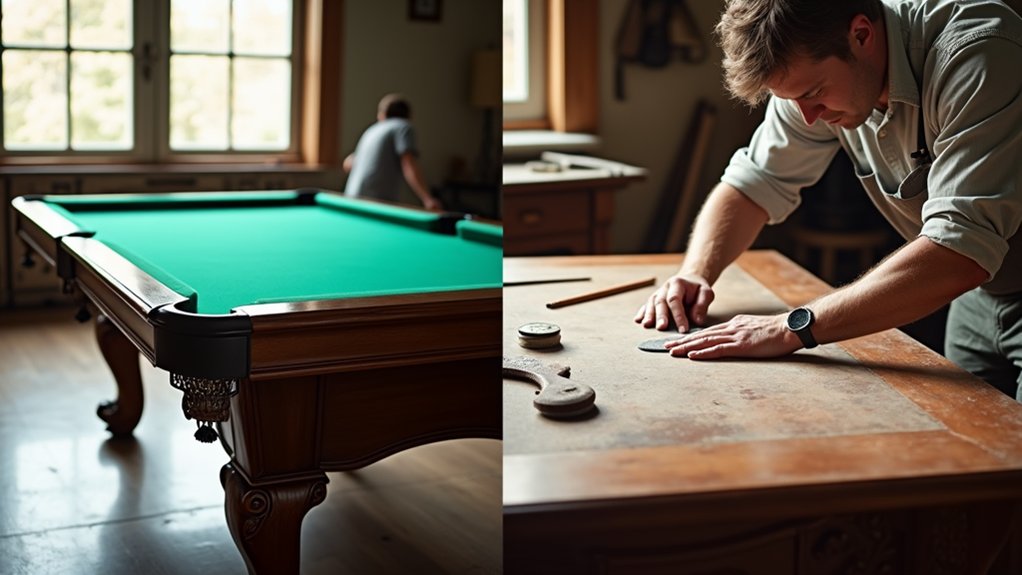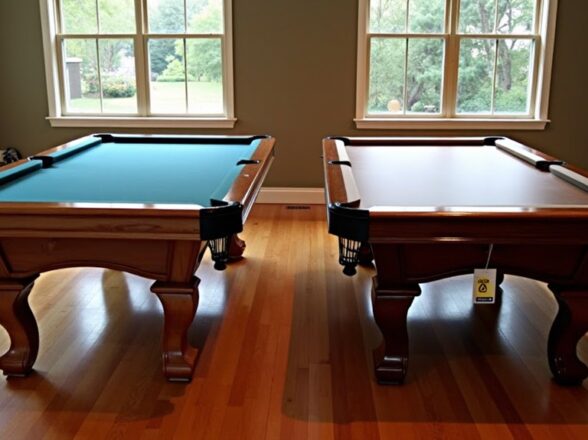What’s the Difference Between Pool Table Repair and Restoration? When to Fix and When to Restore

Pool table repair focuses on fixing specific issues, like damaged felt or loose pockets, which are quicker and less expensive. You should repair minor problems to keep the table functional. On the other hand, restoration aims to return the entire table to its original condition, addressing extensive damage and improving aesthetics. This involves refinishing wood, replacing cushions, or fixing structural issues. If you notice cracked slate or multiple damaged areas, consider a restoration. Knowing when to repair or restore is essential for maintaining your table's quality and longevity. There's more to explore on how to assess and choose services effectively.
Understanding Repair vs. Restoration
When deciding between repair and restoration for your pool table, it's essential to understand the key differences. Pool table repairs focus on fixing specific issues like felt damage or loose pockets. These repairs aim to restore functionality without overhauling the entire table. On the other hand, restoration is an extensive process that seeks to return your pool table to its original aesthetic and operational condition. This often involves refinishing wood and replacing cushions. While pool table repairs are generally quicker and more cost-effective, restoration requires a significant investment of time and money. Knowing when to address common pool table needs can help extend the life of your table and maintain its structural integrity, ensuring an ideal playing surface for years to come.
When to Repair Your Pool Table
How do you know when it's time to repair your pool table? If you're noticing minor issues like rips in the felt, loose pockets, or small structural problems, it's a sign to contemplate repair. Pool table repair services can effectively address these cosmetic issues without a full restoration. Additionally, if the cushions are failing to rebound balls properly but the frame remains stable, cushion replacement may be all you need. Regular maintenance can help manage common wear and tear, which can extend the life of the table. However, if you notice significant damage, like uneven surfaces, a professional assessment is essential to determine if further action is necessary. Repairing your pool table often proves more cost-effective for minor problems.
When to Consider Restoration
If you notice that your pool table is struggling to deliver a smooth playing experience due to significant wear or damage, it might be time to contemplate restoration. For pool table owners, restoring your pool table is essential when you see extensive felt damage or structural issues. If the slate has cracks or if multiple areas of the table need replacement, like pockets and rails, consider a full restoration. Additionally, if your table has historical significance or craftsmanship that deserves preservation, it's worth investing in professional services. They can provide new cushion rubber and high-quality materials, ensuring a durable, enjoyable playing surface. Restoration addresses common pool table needs that simple repairs can't fix, enhancing both function and appearance.
Common Signs of Damage
Recognizing the common signs of damage on your pool table can help you determine the right course of action for maintenance. If you notice an uneven surface where balls don't roll smoothly, it's a sign your pool table needs repair. Worn cloth with cuts or tears affects both playability and appearance. Loose pockets may sag, indicating that the pocket liners need replacement for proper gameplay. Damaged rails, such as cracks or chips, can disrupt your experience and require attention. Additionally, poor cushion response means cushions aren't rebounding balls effectively, signaling a need for replacement. Addressing these issues promptly guarantees you can continue to use your pool table for enjoyable play.
Choosing Professional Services
When it comes to selecting a professional service for your pool table's repair or restoration, doing thorough research can make all the difference. Start by looking for local companies that specialize in your specific type of pool table, as different tables require unique techniques. Reading online reviews can give you insights into their reliability and quality of work. It's wise to obtain multiple quotes to compare pricing and find the best value for your needs. Confirm the service you choose is insured and offers warranties, giving you peace of mind. Finally, prioritize customer service; clear communication about the repair or restoration process is essential for understanding what to expect from the professional service you select.
Frequently Asked Questions
When Should I Recover My Pool Table?
You should recover your pool table when you see signs of wear, like rips or discoloration. Consider recovering methods, materials, and costs, while consulting professionals to guarantee peak gameplay and preserve its value over time.
Can You Restore an Old Pool Table?
Imagine breathing new life into a vintage pool table, its history rich and stories untold. You can restore it using various techniques, but weigh material choices, cost considerations, and whether to tackle DIY or hire professionals.
What Is the Lifespan of a Pool Table?
Your pool table's lifespan varies based on maintenance, felt durability, wood quality, and usage frequency. Common repairs and storage conditions also influence longevity, while brand differences can affect repair costs, making regular upkeep essential.
How Often Should You Re-Clothe Your Pool Table?
You should re-clothe your pool table every 3-5 years, or more frequently with heavy usage. Consider cloth wear, materials, and maintenance tips to enhance game performance. Professional services can help, but weigh cost considerations too.
Conclusion
In conclusion, understanding the difference between repair and restoration can help you maintain your pool table effectively. Repair is best for minor issues, while restoration is ideal for significant damage or age-related wear. As the saying goes, "A stitch in time saves nine." Addressing problems early can save you time and money in the long run. Whether you choose to repair or restore, selecting the right professional service will guarantee your table remains in excellent condition for years to come.
Related posts
Recent posts
Post Categories
Tags
Subscribe





